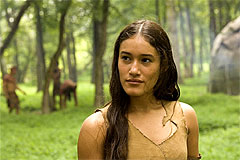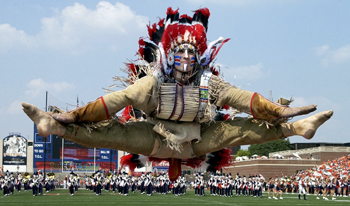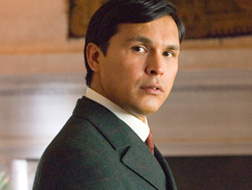Today we're in Lyons, Colorado (north of Boulder and Denver). We're decompressing after taking whirlwind tours of Zion, Bryce Canyon, and Arches National Parks the last three days. We've seen lots of Indian lore and artifacts in the region but no actual Indians yet.
More reports soon!
June 30, 2007
Jimmy Buffett joins Mohegans
Sun Will Shine on Margaritaville
Mohegans, Restaurant Join Forces As Part Of Tribe's Project HorizonWith a tribal prayer uttered as a blessing and margarita glasses clinking a toast, the Mohegan tribe welcomed a new partner, Jimmy Buffett's Margaritaville, Thursday and broke ground for its latest expansion.
“We always give thanks to the Creator,” said Tribal Chairman Bruce “Two Dogs” Bozsum in his native tongue, and then in English, for ... “all You have given us and all things that will come.”
Then, instead of sticking shovels in the dirt—the corporate ceremonial signal that new construction has begun—tribal members and new business partners toasted one another with virgin margaritas as the mayors of Montville and Norwich looked on. 
Mohegans, Restaurant Join Forces As Part Of Tribe's Project Horizon
“We always give thanks to the Creator,” said Tribal Chairman Bruce “Two Dogs” Bozsum in his native tongue, and then in English, for ... “all You have given us and all things that will come.”
Then, instead of sticking shovels in the dirt—the corporate ceremonial signal that new construction has begun—tribal members and new business partners toasted one another with virgin margaritas as the mayors of Montville and Norwich looked on.

Rez to elect prez?
American Indians seeking say in presidential electionsFlexing political muscles in recent elections, an organized American Indian effort now wants a say in presidential elections.
INDN’s List, a moniker for Indigenous Democratic Network, has sought and endorsed American Indian candidates for a host of partisan and non-partisan elections since it was formed in February 2005.
Now, the INDN’s List Education Fund seeks to sponsor the first-ever presidential forum on native issues, called “Prez on the Rez,” in conjunction with an August campaign camp for Indian candidates. 
INDN’s List, a moniker for Indigenous Democratic Network, has sought and endorsed American Indian candidates for a host of partisan and non-partisan elections since it was formed in February 2005.
Now, the INDN’s List Education Fund seeks to sponsor the first-ever presidential forum on native issues, called “Prez on the Rez,” in conjunction with an August campaign camp for Indian candidates.

June 29, 2007
Hot air over Nazca
The Nazca LinesThe Nazca Lines are giant etchings in the desert, created by removing rocks from the sand and piling them up to created vast shapes. These include long, straight lines, running for kilometres, triangles and zigzags, as well as the better-known zoomorphic lines, such as the spider, monkey and hummingbird. Impressive enough as giant desert artwork, it is the mystery behind the lines that gives them their enduring appeal (as well as providing documentary makers with a constant supply of film--the BBC seems to have a Nazca special every couple of years!).
The lines were begun over 2,500 years ago, and the Nazca people probably continued to etch them for hundreds of years. However, modern knowledge of the lines only emerged in 1926 with the first flights over the area by Mejía Jespe. The fact that the lines could only be seen and appreciated from the air has led to many theories, some of which can at best be described as very wild.
One of the stranger theories, discarded by most scientists (although it still has its proponents!), is Erich von Daniken's landing strip for aliens, which he details in his book Chariots of the Gods. Another theory, largely discredited, is that the ancient Nazca people built hot-air balloons from which to view the lines. In the 1980s there was even an experiment to test this theory, which resulted in a balloon quickly returning to earth. Many of these theories are based on the fact that it would have been impossible for the Nazca people to draw giant shapes that they were not able to see themselves. This, of course, is nonsense, and even a basic grasp of geometry would be sufficient to create intricate patterns hundreds of metres in size. Nevertheless, there are suggestions that the Nazca people had moveable wooden viewing platforms from which they would have been able to appreciate the figures. Nazca "Spaceport"An ingenious theory cited by Story is that of the International Explorers Society (IES) of Florida, who suggested that the "chariots of the gods" sailing over Nazca might have been ancient smoke balloons piloted by early Peruvians. This theory was presented in some detail by IES member Jim Woodman in his book NAZCA: Journey to the Sun (1977). Woodman has discovered that the thousands of ancient gravesites around Nazca contain finely woven textiles (suitable for balloon fabric), braided rope, and ceramic pottery. One clay pot has a picture suggesting a hot-air balloon with tie ropes.
It is not generally known that manned balloon flights were recorded in Brazil as early as 1709, when Bartolomeu de Gusmao made his first flight on August 8.
Jim Woodman has actually tested his theory in collaboration with balloonist Julian Nott. They constructed a balloon using the same materials as those available to the ancient Nazcans. The envelope used cotton fabric similar to that in the gravesites; the basket for pilot and co-pilot was woven from native fibers. On November 28, 1975, Woodman and Nott actually flew their balloon (named Condor I) over the Nazca plains.
However, this impressive demonstration hardly settles the mystery of Nazca, since it is not plausible that the Nazcans would have spent centuries constructing these markings for the benefit of occasional balloonists to view from the air. Validation of the theory would require evidence of a religious and cultural milieu in which such balloonists had maintained an elite status for hundreds of years, and it is hardly likely that such balloons would have vanished without a trace. Nazca LinesIn 1977, Jim Woodman accepted that the Nazca people made the lines themselves, but puzzled over why they would make them so big that they couldn't even seen them. He hypothesized that the Nazca people used hot-air balloons for "ceremonial flights" to view their creations. Woodman attempted to demonstrate the validity of his theory by constructing a hot-air balloon out of the materials that would have been available to the Nazca. Using cloth, rope and reeds, Woodman and his colleagues assembled the balloon then risked their lives on a balloon ride that reached a height of 300 feet. The balloon soon descended rapidly; the balloonists bailed out 10 feet above the desert before it crashed some distance away.
In recent years, the professional skeptic Joe Nickell has demonstrated that the drawings would not have been hard to accomplish with only the tools available to the ancient Nazca. Nickell has also shown that although the size of the figures suggests they were intended primarily for the enjoyment of the gods, the drawings can be appreciated from the ground as well.
The general consensus of archaeologists, anthropologists and scientists is that the Nazca Lines were created by the Nazca people themselves, without help from celestial visitors or aerial views. The figures drawn in the desert correspond with images found in other examples of Nazca art, such as pottery. Comment: However the lines were done, they're a remarkable example of Native engineering.

The lines were begun over 2,500 years ago, and the Nazca people probably continued to etch them for hundreds of years. However, modern knowledge of the lines only emerged in 1926 with the first flights over the area by Mejía Jespe. The fact that the lines could only be seen and appreciated from the air has led to many theories, some of which can at best be described as very wild.
One of the stranger theories, discarded by most scientists (although it still has its proponents!), is Erich von Daniken's landing strip for aliens, which he details in his book Chariots of the Gods. Another theory, largely discredited, is that the ancient Nazca people built hot-air balloons from which to view the lines. In the 1980s there was even an experiment to test this theory, which resulted in a balloon quickly returning to earth. Many of these theories are based on the fact that it would have been impossible for the Nazca people to draw giant shapes that they were not able to see themselves. This, of course, is nonsense, and even a basic grasp of geometry would be sufficient to create intricate patterns hundreds of metres in size. Nevertheless, there are suggestions that the Nazca people had moveable wooden viewing platforms from which they would have been able to appreciate the figures.
It is not generally known that manned balloon flights were recorded in Brazil as early as 1709, when Bartolomeu de Gusmao made his first flight on August 8.
Jim Woodman has actually tested his theory in collaboration with balloonist Julian Nott. They constructed a balloon using the same materials as those available to the ancient Nazcans. The envelope used cotton fabric similar to that in the gravesites; the basket for pilot and co-pilot was woven from native fibers. On November 28, 1975, Woodman and Nott actually flew their balloon (named Condor I) over the Nazca plains.
However, this impressive demonstration hardly settles the mystery of Nazca, since it is not plausible that the Nazcans would have spent centuries constructing these markings for the benefit of occasional balloonists to view from the air. Validation of the theory would require evidence of a religious and cultural milieu in which such balloonists had maintained an elite status for hundreds of years, and it is hardly likely that such balloons would have vanished without a trace.
In recent years, the professional skeptic Joe Nickell has demonstrated that the drawings would not have been hard to accomplish with only the tools available to the ancient Nazca. Nickell has also shown that although the size of the figures suggests they were intended primarily for the enjoyment of the gods, the drawings can be appreciated from the ground as well.
The general consensus of archaeologists, anthropologists and scientists is that the Nazca Lines were created by the Nazca people themselves, without help from celestial visitors or aerial views. The figures drawn in the desert correspond with images found in other examples of Nazca art, such as pottery.

June 28, 2007
The buffalo nickel design
"Return of the Buffalo Nickel"The designer of the old buffalo nickel was James Earle Fraser. This is the same guy who did the famous sculpture, “End of the Trail,” now featured in the National Cowboy and Western Heritage Museum, Oklahoma City. Fraser, born in 1876 in Winona, Minnesota, grew up in Mitchell, South Dakota, and thus claimed an affinity with western images.
Fraser for a time was an apprentice to Irish-born sculptor Augustus Saint-Gaudens, the fellow who convinced President Theodore Roosevelt the country needed new designs for its $10 and $20 gold pieces. Saint-Gaudens’s gold coins were striking, but because the artist insisted on high relief, they did not stack well, so that eventually the mint altered his designs. The original buffalo nickel also would have technical design problems, especially in relation to vending machines, stemming from Fraser’s artistic specifications.
It was Secretary of the Treasury Franklin MacVeagh, a Roosevelt appointee, who commissioned Fraser, Saint-Gaudens’s protégé, to design the buffalo nickel. Not only the buffalo on the coin but also the Indian head on the other side was the object of controversy. Fraser said he made up the profile as a composite of three models: a Cheyenne named Two Moons, a Sioux (Dakota, Lakota?) named Iron Tail, and a third one he could not remember.
Subsequently a Seneca named Big Tree presented himself to the public as the unknown model. This seemed plausible, since Fraser then recalled using an Indian of that name, but it turns out that the Seneca Big Tree, like several other pretenders, was a fraud. Fraser finally recalled that his Big Tree was a Kiowa. Comment: Is this the same Chief Big Tree who starred in Drums Along the Mohawk? Hmm.

Fraser for a time was an apprentice to Irish-born sculptor Augustus Saint-Gaudens, the fellow who convinced President Theodore Roosevelt the country needed new designs for its $10 and $20 gold pieces. Saint-Gaudens’s gold coins were striking, but because the artist insisted on high relief, they did not stack well, so that eventually the mint altered his designs. The original buffalo nickel also would have technical design problems, especially in relation to vending machines, stemming from Fraser’s artistic specifications.
It was Secretary of the Treasury Franklin MacVeagh, a Roosevelt appointee, who commissioned Fraser, Saint-Gaudens’s protégé, to design the buffalo nickel. Not only the buffalo on the coin but also the Indian head on the other side was the object of controversy. Fraser said he made up the profile as a composite of three models: a Cheyenne named Two Moons, a Sioux (Dakota, Lakota?) named Iron Tail, and a third one he could not remember.
Subsequently a Seneca named Big Tree presented himself to the public as the unknown model. This seemed plausible, since Fraser then recalled using an Indian of that name, but it turns out that the Seneca Big Tree, like several other pretenders, was a fraud. Fraser finally recalled that his Big Tree was a Kiowa.

June 27, 2007
Off to Colorado
My girlfriend and I are driving to Lyons, Colorado, to visit her sister. We'll be gone nine days. Internet connections and therefore blog postings may be sporadic during that time.
Think of this as our "Looking for Indians in the New West" tour. We'll be visiting national parks and Indian reservations as well as cities and museums. Look for occasional road reports and lots of pictures when we return.
Rob
Think of this as our "Looking for Indians in the New West" tour. We'll be visiting national parks and Indian reservations as well as cities and museums. Look for occasional road reports and lots of pictures when we return.
Rob
"Long Train of Abuses"
From a MySpace bulletin:"Long Train of Abuses" takes a look at the issues that First Nations in Canada are experiencing. The video will also take a look back at the blockades and confrontations of the past between Canada and The First Nations People.
Once again, we try to get people understanding the issues. Please view the video "Long Train of Abuses" on YouTube. Try to circulate the following links to as many as you can.
Part 1
Part 2
The effort is as we said, we want to wake up the Americans from their long sleep and see if they can stop their addiction to Paris Hilton long enough to view some news from Canada.
The video is self explanatory. We need help to ensure that it is effective in getting the message out. The same message we tried to give in 2006.
The situation between indigenous people and the rest of Canada is dangerously close to confrontation whether that confrontation happens this summer or later. It is our duty to ensure that people do not ignore the consequences of inaction.
Chief Terrance Nelson
Once again, we try to get people understanding the issues. Please view the video "Long Train of Abuses" on YouTube. Try to circulate the following links to as many as you can.
Part 1
Part 2
The effort is as we said, we want to wake up the Americans from their long sleep and see if they can stop their addiction to Paris Hilton long enough to view some news from Canada.
The video is self explanatory. We need help to ensure that it is effective in getting the message out. The same message we tried to give in 2006.
The situation between indigenous people and the rest of Canada is dangerously close to confrontation whether that confrontation happens this summer or later. It is our duty to ensure that people do not ignore the consequences of inaction.
Chief Terrance Nelson
Uncovering New Age frauds
New Age Frauds & Plastic ShamansDo you think you are "Indian at heart" or were an Indian in a past life? Do you admire native ways and want to incorporate them into your life and do your own version of a sweat lodge or a vision quest? Have you seen ads, books, and websites that offer to train you to be come a shaman in an easy number of steps, a few days on the weekend, or for a fee?
Have you really thought this all the way through? Have you thought about how native people feel about what you might want to do?
Please think about these important points before you take that fateful step and expend time, money, and emotional investment:
Native people DO NOT believe it is ethical to charge money for any ceremony or teaching. Any who charge you even a penny are NOT authentic.
Native traditionalists believe the ONLY acceptable way to transmit traditional teachings is orally and face-to-face. Any allegedly traditional teachings in books or on websites are NOT authentic.
Learning medicine ways takes decades and must be done with great caution and patience out of respect for the sacred. Any offer to teach you all you need to know in a weekend seminar or two is wishful thinking at best, fraud at worst. 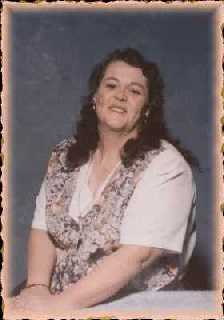
Have you really thought this all the way through? Have you thought about how native people feel about what you might want to do?
Please think about these important points before you take that fateful step and expend time, money, and emotional investment:
Native people DO NOT believe it is ethical to charge money for any ceremony or teaching. Any who charge you even a penny are NOT authentic.
Native traditionalists believe the ONLY acceptable way to transmit traditional teachings is orally and face-to-face. Any allegedly traditional teachings in books or on websites are NOT authentic.
Learning medicine ways takes decades and must be done with great caution and patience out of respect for the sacred. Any offer to teach you all you need to know in a weekend seminar or two is wishful thinking at best, fraud at worst.

Indian dog training?
"You're About To Learn Secrets That Most People Will Never Know About Training Native American Indian Dogs..."Sign up right now and we'll send you helpful tips for training your Native American Indian Dog including:
* The #1 Reason your Native American Indian Dog is misbehaving, and how you can banish bad behavior today.
* The hidden psychological trigger that all Native American Indian Dogs have ...that will allow you to practically have "mind control" over your dog.
* Why scolding and punishing your Native American Indian Dog does NOT work and actually makes training harder.
* The fun way to train your Native American Indian Dog in just 15 minutes a day, even if you've never had good luck training your dog in the past.
* And much, much more...
* The #1 Reason your Native American Indian Dog is misbehaving, and how you can banish bad behavior today.
* The hidden psychological trigger that all Native American Indian Dogs have ...that will allow you to practically have "mind control" over your dog.
* Why scolding and punishing your Native American Indian Dog does NOT work and actually makes training harder.
* The fun way to train your Native American Indian Dog in just 15 minutes a day, even if you've never had good luck training your dog in the past.
* And much, much more...
June 26, 2007
Pageant winner has talent, message
Meet Miss Indian Farmington: Navajo teen hopes to send message of respectMariah Kay Bolding isn't your typical beauty queen.
"When a boy opens the door, I want him to go in first," the new Miss Indian Farmington said.
The 16-year-old pageant veteran has a similarly strong message for other Native teens in Farmington: Be yourself. Respect your culture. Don't let your mistakes hold you back.
Bolding grew up in both Shiprock and Farmington. "In Shiprock, younger people are more involved in tradition," she said. "Being out here, kids my age and younger are ashamed of being Native American. They don't participate in events ... they make fun of things, kind of teasing."
That's at least in part, she said, because young people encounter prejudice, and she isn't immune. After she moved to Farmington permanently in the seventh grade, for a time she rejected the Navajo traditions her aunt taught her. Her talents:For the traditional talent segment, Bolding sung Navajo songs her aunt taught her. For her modern talent she showed off fashion designs, contrasting trends with classic looks. "I was really worried about it before the pageant," Nolan said. She asked her daughter if she needed any help preparing. "She said, 'Mom, don't worry about it. I have it under control.'"
Looking forward, the incoming high school junior wants to either enter the military, then join the FBI or the CIA, or become a fashion designer. "I want to make something of myself," she said. "I want to show people that if you work hard, you'll get it." Comment: Let's not forget that beauty pageants are a Western invention. The concept is foreign to Native cultures.

"When a boy opens the door, I want him to go in first," the new Miss Indian Farmington said.
The 16-year-old pageant veteran has a similarly strong message for other Native teens in Farmington: Be yourself. Respect your culture. Don't let your mistakes hold you back.
Bolding grew up in both Shiprock and Farmington. "In Shiprock, younger people are more involved in tradition," she said. "Being out here, kids my age and younger are ashamed of being Native American. They don't participate in events ... they make fun of things, kind of teasing."
That's at least in part, she said, because young people encounter prejudice, and she isn't immune. After she moved to Farmington permanently in the seventh grade, for a time she rejected the Navajo traditions her aunt taught her.
Looking forward, the incoming high school junior wants to either enter the military, then join the FBI or the CIA, or become a fashion designer. "I want to make something of myself," she said. "I want to show people that if you work hard, you'll get it."

Lakota to lead Baha'is
Lakota woman elected to head U.S. Baha'is' national assemblyJacqueline Left Hand Bull-Delahunt has been chosen as the first American Indian woman to head the National Spiritual Assembly of the Baha'is of the United States.
Left Hand Bull-Delahunt, a member of the Rosebud Sioux Tribe, was brought up by traditional Lakota grandparents and parents. She became a member of the Baha'is more than 20 years ago.
The change to the Baha'is was not a large leap for Left Hand Bull-Delahunt. The spirituality is very similar to that of her Lakota upbringing, she said.
"I knew about the beauty and power of our traditional ways and the Catholic Church could not accommodate them," she said. "I was always a little bit confused. Then I heard about the Baha'i faith." 
Left Hand Bull-Delahunt, a member of the Rosebud Sioux Tribe, was brought up by traditional Lakota grandparents and parents. She became a member of the Baha'is more than 20 years ago.
The change to the Baha'is was not a large leap for Left Hand Bull-Delahunt. The spirituality is very similar to that of her Lakota upbringing, she said.
"I knew about the beauty and power of our traditional ways and the Catholic Church could not accommodate them," she said. "I was always a little bit confused. Then I heard about the Baha'i faith."

Zia the hot spot
Variety: Zia Pueblo a 'hot spot' for HollywoodZia Pueblo in New Mexico is one of the state's "top locations" for Hollywood movies, Variety reports.
"Rather than opening a casino, the Zia tribe decided to allow film production on their lands," Variety says. "'The Missing' and 'All the Pretty Horses' took advantage of the territory's diverse landscape, which includes cliffs, valleys and a surreal gypsum quarry. The latter doubled as the Red Planet in 'John Carpenter's Ghosts of Mars.'"
Other hot spots include the Albuquerque Rail Yards and White Sands National Monument. Movie production has ramped up during the administration of Gov. Bill Richardson (D). 
"Rather than opening a casino, the Zia tribe decided to allow film production on their lands," Variety says. "'The Missing' and 'All the Pretty Horses' took advantage of the territory's diverse landscape, which includes cliffs, valleys and a surreal gypsum quarry. The latter doubled as the Red Planet in 'John Carpenter's Ghosts of Mars.'"
Other hot spots include the Albuquerque Rail Yards and White Sands National Monument. Movie production has ramped up during the administration of Gov. Bill Richardson (D).

June 25, 2007
Review of D Is for Drum
Debbie and Michael Shoulder's D is for Drum: A Native American AlphabetThis title presents a mishmash of Indian cultural snippets, presented alphabetically and in rhyme, paired with side panels that purport to offer more information about each topic. Abysmally written, with trite error-laden rhymes and boring yet confusing “informational” text, the poor attempts at iambic pentameter highlight this cockamamie piece of dreck, typical of the quality of work of a press known for its picture books of made-up “Indian legends” that have become best sellers in Michigan and the Great Lakes Area.
The text veers between past and present tense, the selections are illogical and odd, and the rhymes are even odder:
Native Names are important words.
They’re given to newborns with care.
Honi means wolf, Woya means dove,
and Nita is Choctaw for bear. (Excerpted from Debbie Reese's American Indians in Children's Literature, 6/18/07.)
Comment: For more information, see the previous write-up of this book.

The text veers between past and present tense, the selections are illogical and odd, and the rhymes are even odder:
Native Names are important words.
They’re given to newborns with care.
Honi means wolf, Woya means dove,
and Nita is Choctaw for bear.
Comment: For more information, see the previous write-up of this book.

NATV only months away
NATV: There’s Something Happening Here...and It’s MajorNative American Television (NATV) is literally right around the corner; just months away from beaming into the living rooms of Americans from all corners of the map and what this means—what this means—is light years beyond another channel on our dish network.
What this means is that for the first time mainstream America will be introduced to images of Native Americans-Aboriginals-Indians that weren’t fabricated in the TNT penthouse offices or in grainy black-and-white westerns or plastered on motel signs along Route 66. In other words, beyond leather-and-feathers, casinos, Pine Ridge, and Chief Wahoo.
And more. An educational program, based out of metro D.C., which will take emerging media talent from Indian Country (for those of you who don’t know, that’s everywhere) and provide hands on training, and more importantly, opportunities for young Natives to put their skills to the test. Comment: I'm pretty sure NATV is only figuratively around the corner, not literally around the corner. ;-)
What this means is that for the first time mainstream America will be introduced to images of Native Americans-Aboriginals-Indians that weren’t fabricated in the TNT penthouse offices or in grainy black-and-white westerns or plastered on motel signs along Route 66. In other words, beyond leather-and-feathers, casinos, Pine Ridge, and Chief Wahoo.
And more. An educational program, based out of metro D.C., which will take emerging media talent from Indian Country (for those of you who don’t know, that’s everywhere) and provide hands on training, and more importantly, opportunities for young Natives to put their skills to the test.
Superfly filmmakers
Young Native filmmakers get a boost at festivalYoung Native filmmakers participated in Longhouse Media's 36-hour filmmaking workshop June 7-9 as part of the Seattle International Film Festival.
In the workshop, called SuperFly, the young filmmakers were placed in five teams and given a script written for them by Sterlin Harjo, the 25-year-old Seminole/Creek director of "Four Sheets to the Wind," a favorite at the 2007 Sundance Film Festival, according to a relsease. The groups had 36 hours to storyboard, shoot and edit their films, which premiered at the film festival June 9 at the Egyptian Theatre.
"SuperFly" is a term that reflects the short time filmmakers have to produce their films, hence the term "fly filmmaking" or "filmmaking on the fly."
In the workshop, called SuperFly, the young filmmakers were placed in five teams and given a script written for them by Sterlin Harjo, the 25-year-old Seminole/Creek director of "Four Sheets to the Wind," a favorite at the 2007 Sundance Film Festival, according to a relsease. The groups had 36 hours to storyboard, shoot and edit their films, which premiered at the film festival June 9 at the Egyptian Theatre.
"SuperFly" is a term that reflects the short time filmmakers have to produce their films, hence the term "fly filmmaking" or "filmmaking on the fly."
Sacred site or casino?
Sacred site focus of tribal tug of war
Location of casino causes Quechan riftTwo days before the groundbreaking, the tribe and local law enforcement officers forcibly removed a small group of tribal members holding a religious ceremony on the site in protest of the project.
The protesters, including Priscilla Prettybird, contend the site is part of a larger prehistoric ceremonial and gathering area used by at least five tribes, which cremated their ancestors there.
The casino site also is near a mountain known as Pilot Knob, a landmark that tribal officials singled out during the gold mine fight as hallowed ground to the Quechan and other tribes that once inhabited the desert region. 
Location of casino causes Quechan rift
The protesters, including Priscilla Prettybird, contend the site is part of a larger prehistoric ceremonial and gathering area used by at least five tribes, which cremated their ancestors there.
The casino site also is near a mountain known as Pilot Knob, a landmark that tribal officials singled out during the gold mine fight as hallowed ground to the Quechan and other tribes that once inhabited the desert region.

June 24, 2007
NATV is coming
Native American Television (NATV) Receives Groundbreaking Support from the Affiliated Tribes of Northwest IndiansNative American Television (NATV), the nationwide, nonprofit multimedia network and training organization providing all-indigenous television programming, has received a groundbreaking endorsement from the Affiliated Tribes of Northwest Indians supporting the network’s $5 million fundraising campaign for 2007.
The Affiliated Tribes, representing 55 Indian nations in six states, passed a resolution at their semi-annual conference on May 24 supporting NATV’s mission to create an Indian voice in television and educate young Native media professionals. The significance of such a public proclamation for the upstart network can’t be underestimated.
“Getting out there and presenting Indians news and an Indian point-of-view is of the utmost importance,” says Ernie Stensgar (Coeur d’Alene), chairman of the Affiliated Tribes of Northwest Indians and NATV board member. “Although the concept has been out there, now is the time to present the truth about Indians and what we’re doing in the United States. Another important aspect is getting Indian reporters and news people behind the scenes. And that means from operating the cameras to doing all the technical aspects of all of this.”
With the resolution, the Affiliated Tribes have committed to financially supporting NATV as it moves ever closer to officially launching this year. The network is currently working with partners and independent producers to provide content for its viewers—all Native, all the time, nationwide. These facts, plus their strategically located studio and training facilities based in the Washington D.C. metropolitan area, will shake the prevailing image most Americans have of Indians, notes NATV Board chairperson Dr. James May (United Keetoowah Band.) 
The Affiliated Tribes, representing 55 Indian nations in six states, passed a resolution at their semi-annual conference on May 24 supporting NATV’s mission to create an Indian voice in television and educate young Native media professionals. The significance of such a public proclamation for the upstart network can’t be underestimated.
“Getting out there and presenting Indians news and an Indian point-of-view is of the utmost importance,” says Ernie Stensgar (Coeur d’Alene), chairman of the Affiliated Tribes of Northwest Indians and NATV board member. “Although the concept has been out there, now is the time to present the truth about Indians and what we’re doing in the United States. Another important aspect is getting Indian reporters and news people behind the scenes. And that means from operating the cameras to doing all the technical aspects of all of this.”
With the resolution, the Affiliated Tribes have committed to financially supporting NATV as it moves ever closer to officially launching this year. The network is currently working with partners and independent producers to provide content for its viewers—all Native, all the time, nationwide. These facts, plus their strategically located studio and training facilities based in the Washington D.C. metropolitan area, will shake the prevailing image most Americans have of Indians, notes NATV Board chairperson Dr. James May (United Keetoowah Band.)

Montclair exhibit opens in July
POW! Superheroes hit MAM this SummerThe Montclair Art Museum (MAM) has announced the July 14th opening of a first-of-its-kind exhibition, Reflecting Culture: The Evolution of American Comic Book Superheroes on view until January 13, 2008. The exhibition traces the way in which comic books have reflected an ever-evolving American culture through more than 150 original drawings, rare comic books and graphic novels from the Golden Age of comics (1938-1946) to the present. Never-before-seen original drawings and other work from the private collection of area resident Michael Uslan, producer of Batman and Batman Begins, will be the cornerstone of this exhibit, which unites seminal work of the genre from private collections around the country.
Curated by MAM’s Chief Curator Gail Stavitsky, with assistance from Curator of Native American Art Twig Johnson, and award-winning film producer and comic book collector Michael Uslan, Reflecting Culture: The Evolution of American Comic Book Superheroes examines the modern comic book, from its humble origins in 1934 as the reprinted pages of Sunday newspaper comic strips, to its ascent as a thriving industry that has fueled the American imagination, to the enormous successes of its contemporary offspring, the Hollywood blockbuster film. 
Curated by MAM’s Chief Curator Gail Stavitsky, with assistance from Curator of Native American Art Twig Johnson, and award-winning film producer and comic book collector Michael Uslan, Reflecting Culture: The Evolution of American Comic Book Superheroes examines the modern comic book, from its humble origins in 1934 as the reprinted pages of Sunday newspaper comic strips, to its ascent as a thriving industry that has fueled the American imagination, to the enormous successes of its contemporary offspring, the Hollywood blockbuster film.

My documentary debut
Chip Cronkite, son of Walter, is producing a documentary to accompany the Montclair Art Museum's exhibit. He's interviewing the legends in the field--Stan Lee, Roy Thomas, Dick Giordano, Johnny Romita, Joe Kubert--on the evolution of comics.
Because the Montclair specializes in Native art, Cronkite wanted to get a Native perspective on comics also. At the urging of Twig Johnson and Gail Stavitsky, he contacted me.
After interviewing Stan Lee in Los Angeles Wednesday, Cronkite came by and interviewed me. I said all the usual things about PEACE PARTY and Natives in comics.
If my comments don't end up on the cutting-room floor, I should be in the documentary when it debuts in September. Stan Lee and me: two comic-book giants!
(Just kidding, of course.)

Because the Montclair specializes in Native art, Cronkite wanted to get a Native perspective on comics also. At the urging of Twig Johnson and Gail Stavitsky, he contacted me.
After interviewing Stan Lee in Los Angeles Wednesday, Cronkite came by and interviewed me. I said all the usual things about PEACE PARTY and Natives in comics.
If my comments don't end up on the cutting-room floor, I should be in the documentary when it debuts in September. Stan Lee and me: two comic-book giants!
(Just kidding, of course.)

Four Sheets on the move
NMAI Presents Sundance Winner “Four Sheets to the Wind”Described by the Hollywood Reporter as an “enchanting and decidedly idiosyncratic...in the best tradition of coming-of-age films,” Four Sheets to the Wind tells the story of Cufe Smallhill (Cody Lightning). When he finds his father dead beside a bottle of pills, Cufe fulfills his promise to sink the body in the family pond. A fake funeral, held for the community, brings together a family that has drifted apart. Wondering if there is more to life than what’s on offer in his small home town, Cufe heads for the city of Tulsa with his sister Miri (Tamara Podemski), and explores his new possibilities with Miri’s neighbor, the lovable Francie (Laura Bailey).
Four Sheets to the Wind premiered at the 2007 Sundance Film Festival, earning Podemski (Saulteaux) the coveted Special Jury Award for her role as Miri Smallhill. Harjo is a 2004 Sundance Institute Annenberg Fellow, a 2006 Renew Media Fellow, and the 2006 winner of the Tribeca All Access Creative Promise Award for Narrative Film. 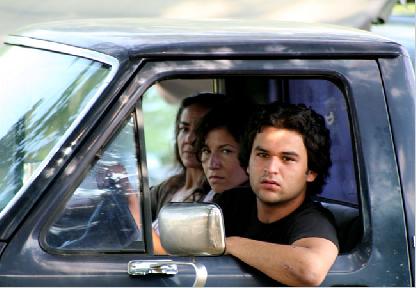
Four Sheets to the Wind premiered at the 2007 Sundance Film Festival, earning Podemski (Saulteaux) the coveted Special Jury Award for her role as Miri Smallhill. Harjo is a 2004 Sundance Institute Annenberg Fellow, a 2006 Renew Media Fellow, and the 2006 winner of the Tribeca All Access Creative Promise Award for Narrative Film.

June 23, 2007
How Arkansas State "honors" Indians
Fans react to ASU's proposed name change"We always thought we were honoring the Indians," Vangilder said. "We never thought it was a derogatory thing."
Since August 2005, the NCAA had been putting pressure on Arkansas State to drop its nickname, considered offensive by many Native Americans. ASU landed on a list of nine Division 1 schools that the NCAA claimed were in violation of its ban of ethnically "hostile" or "abusive" nicknames.
"We've been involved for a long time in encouraging schools to change those names," said Paula Stabler, communications officer for Osage Nation, a tribe based in Oklahoma. ASU Indian History"Indians" is taken from the heritage of the state of Arkansas—from the Osage tribe which roamed Northern Arkansas before the settlers arrived. During the 18th Century the Osage were at war with practically all other tribes of the plains, as well as with the woodland tribes. For that reason, ASUers look with pride to the fighting spirit which dwelled among the Indians of Northern Arkansas.
The Indian Family consists the Chief, the Brave and the Princess. The princess is a person with internal and external beauty. Through the eyes of the young Princess, we see the beauty of the campus and its people. Next is the Brave, through the eyes of the Brave, we see a willingness to forge bravely ahead to our future, succeeding with grit and determination. Finally, the head of the Indian Family—Chief Big Track, with great wisdom and patience. He quietly maintains pride within the family and keeps ASU traditions alive. From the article again:At the Totem Pole Pawn Shop, where everything from golf clubs to guns--lots and lots of guns--are available for purchase, owners Johnny and Joanna Clines said they have no plans to change the name of their business. They have a laissez faire attitude when it comes to the committee's recommendation.
"If the school wants to change it," Joanna Clines said, "they should change it."
That said, the Clines, who regularly attend ASU football games with their 12-year-old daughter, Ranae, have zero intention of removing the oversized painting of "Spirit Joe" that occupies one of their large storefront windows. "Spirit Joe" is a cartoonish figure of a Native American man that was retired from official use as a school mascot in 1995. That decision was made, according to the school, to "uphold the dignity, stateliness and pride of the native American Indians who once inhabited this area." 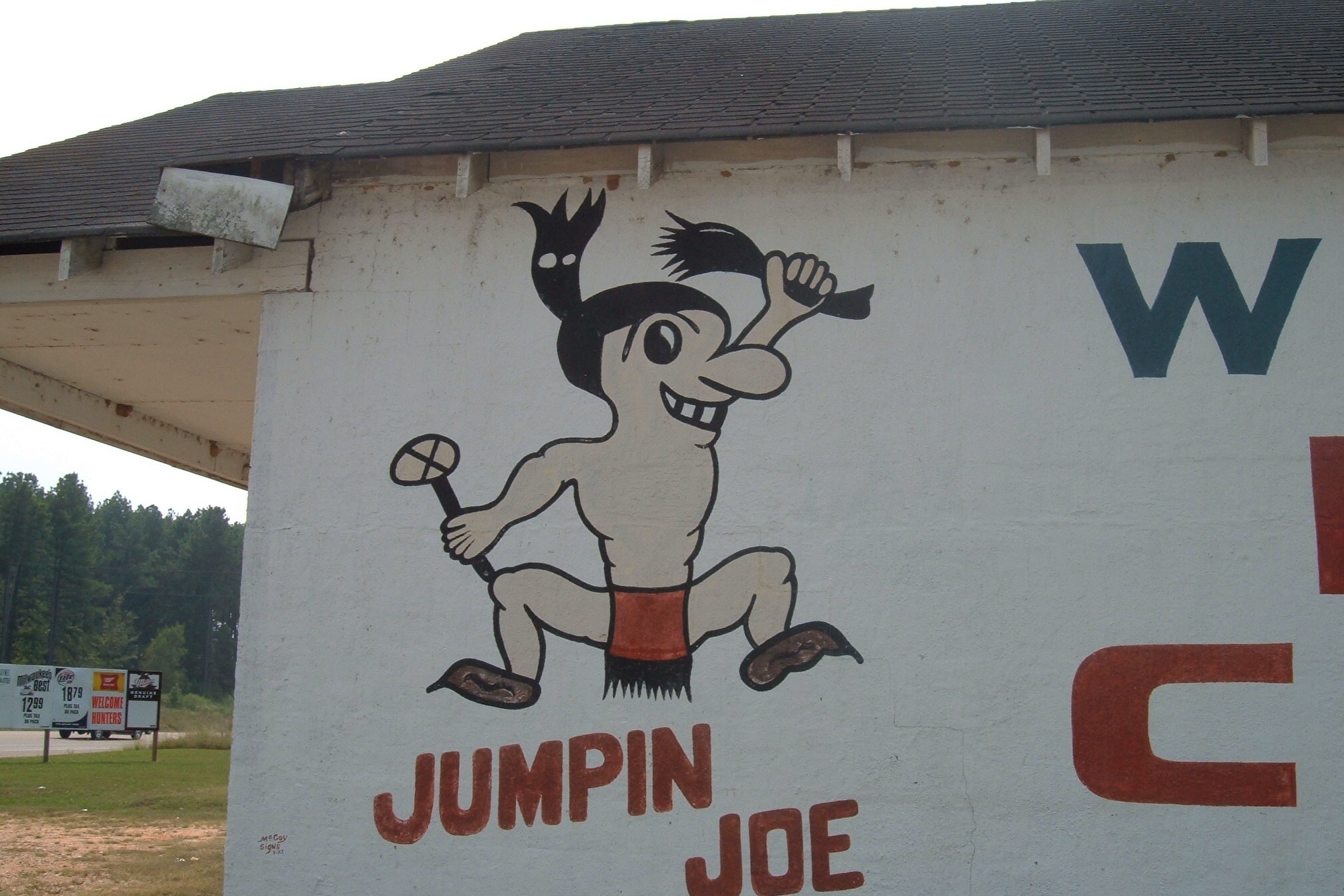
Since August 2005, the NCAA had been putting pressure on Arkansas State to drop its nickname, considered offensive by many Native Americans. ASU landed on a list of nine Division 1 schools that the NCAA claimed were in violation of its ban of ethnically "hostile" or "abusive" nicknames.
"We've been involved for a long time in encouraging schools to change those names," said Paula Stabler, communications officer for Osage Nation, a tribe based in Oklahoma.
The Indian Family consists the Chief, the Brave and the Princess. The princess is a person with internal and external beauty. Through the eyes of the young Princess, we see the beauty of the campus and its people. Next is the Brave, through the eyes of the Brave, we see a willingness to forge bravely ahead to our future, succeeding with grit and determination. Finally, the head of the Indian Family—Chief Big Track, with great wisdom and patience. He quietly maintains pride within the family and keeps ASU traditions alive.
"If the school wants to change it," Joanna Clines said, "they should change it."
That said, the Clines, who regularly attend ASU football games with their 12-year-old daughter, Ranae, have zero intention of removing the oversized painting of "Spirit Joe" that occupies one of their large storefront windows. "Spirit Joe" is a cartoonish figure of a Native American man that was retired from official use as a school mascot in 1995. That decision was made, according to the school, to "uphold the dignity, stateliness and pride of the native American Indians who once inhabited this area."

2007 Reading Red report
Reading Red: Report finds lack of coverageThe good news is, not many negative stories about Native Americans appeared in U.S. major daily newspapers last year.
The bad news is, not many stories of any kind about Native Americans appeared. And when they were written, they hardly used Natives as sources. The mix of topics: In the five years since the last study, the topics being reported have changed, Azocar said. In 2001, the top Native American topics were reservation life, casinos and mascots. Last year they were arts and entertainment, education and casinos.
Of the 4,684 sources quoted in the stories, just over a quarter were Native American, even in cities that have a high Native population. In fact, having a high Native population didn't necessarily correlate with thorough coverage of Natives. The persistence of stereotypes:An enduring stereotype Azocar found was one she calls "the Indian as spiritual creature."
Even in stories that had nothing to do with religion, reporters seemed to assign Native sources an aura of mysticism. For example, Native singing was often described as "chanting"--"and it's always 'ancient,'" pointed out an audience member.
One story described a Native elder as having "appeared out of nowhere," "because, you know, we can all do that," Azocar said wryly. Comment: There's definitely been an explosion of arts and entertainment news in the last year or two. In the past, you wouldn't have seen so much press for Native movies (Apocalypto, Bury My Heart at Wounded Knee), plays (the Native Voices productions, Wakonda's Dream), books (Thirteen Moons, Flight), video games (Prey), or comic books (SCALPED).
You can read about the original Reading Red report at Native Journalism: To Tell the Truth.
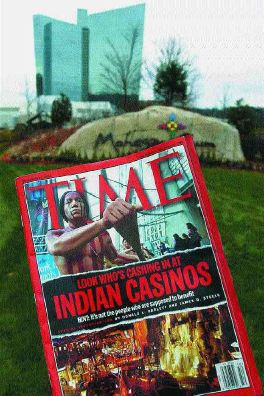
The bad news is, not many stories of any kind about Native Americans appeared. And when they were written, they hardly used Natives as sources.
Of the 4,684 sources quoted in the stories, just over a quarter were Native American, even in cities that have a high Native population. In fact, having a high Native population didn't necessarily correlate with thorough coverage of Natives.
Even in stories that had nothing to do with religion, reporters seemed to assign Native sources an aura of mysticism. For example, Native singing was often described as "chanting"--"and it's always 'ancient,'" pointed out an audience member.
One story described a Native elder as having "appeared out of nowhere," "because, you know, we can all do that," Azocar said wryly.
You can read about the original Reading Red report at Native Journalism: To Tell the Truth.

Angelina Jolie in blackface
A Part Colored By History
Choice of White Actress For Mixed-Race Role Stirs Debate on Insensitivity"I am screaming my head off about Angelina Jolie playing Mariane Pearl, who is half-black."
But others argue that the Jolie naysayers are practicing reverse racism. Said a contributor on TheZeroBoss.com: "Mariane Pearl is mostly white . . . what are you practicing here, the one drop rule?"
(Jolie, it should be noted, claims some nonwhite ancestry. Her mother was reportedly part Iroquois.)
The debate is cast against the backdrop of the United States' troubled legacy of minstrel shows, where white actors slapped on burnt cork or shoe polish, the better to mock African Americans. Film stars Bing Crosby, Bob Hope and Eddie Cantor performed in blackface, as did actors in D.W. Griffith's "Birth of a Nation," using greasepaint and murderous stereotypes to reinforce America's worst fears about black men. Even as recently as 1993, actor Ted Danson donned blackface to roast then-girlfriend Whoopi Goldberg at the Friars Club.
Hollywood didn't confine this phenomenon to its depiction of African Americans. White actors including Mickey Rooney, Katharine Hepburn and Shirley MacLaine have donned the brown-, red- and yellow-face, too, playing Native Americans, Latinos and Asians, usually to stereotypical effect. Then consider that Forest Whitaker darkened his skin to play Ugandan dictator Idi Amin in "The Last King of Scotland," and the issue gets complicated: Does that count as blackface, or is it akin to Nicole Kidman's donning a prosthetic nose to play Virginia Woolf in "The Hours"? Comment: I just saw A Mighty Heart. It's good. I give it an 8.0 of 10.

Choice of White Actress For Mixed-Race Role Stirs Debate on Insensitivity
But others argue that the Jolie naysayers are practicing reverse racism. Said a contributor on TheZeroBoss.com: "Mariane Pearl is mostly white . . . what are you practicing here, the one drop rule?"
(Jolie, it should be noted, claims some nonwhite ancestry. Her mother was reportedly part Iroquois.)
The debate is cast against the backdrop of the United States' troubled legacy of minstrel shows, where white actors slapped on burnt cork or shoe polish, the better to mock African Americans. Film stars Bing Crosby, Bob Hope and Eddie Cantor performed in blackface, as did actors in D.W. Griffith's "Birth of a Nation," using greasepaint and murderous stereotypes to reinforce America's worst fears about black men. Even as recently as 1993, actor Ted Danson donned blackface to roast then-girlfriend Whoopi Goldberg at the Friars Club.
Hollywood didn't confine this phenomenon to its depiction of African Americans. White actors including Mickey Rooney, Katharine Hepburn and Shirley MacLaine have donned the brown-, red- and yellow-face, too, playing Native Americans, Latinos and Asians, usually to stereotypical effect. Then consider that Forest Whitaker darkened his skin to play Ugandan dictator Idi Amin in "The Last King of Scotland," and the issue gets complicated: Does that count as blackface, or is it akin to Nicole Kidman's donning a prosthetic nose to play Virginia Woolf in "The Hours"?

Virginia's "lost" tribe
Trail Exposes Hidden History of Va. Indians
Endeavor Aims to Refocus Perceptions, Studies of Tribal CulturesThe Monacan Indians were often referred to as a "lost" Virginia tribe. They say they were only able to survive as a nation hundreds of years after colonists thought they'd died out because they lived in the middle of nowhere. And now that the 400th anniversary of Jamestown has revived interest in Virginia Indian culture and Virginia Indians are desperate to let people know they're still around, they're finding that most have no idea who they are, where they are or how to find them.
Enter the Virginia Indian Heritage Trail guide, an 80-page book with photographs, a history of the eight state-recognized tribes, a calendar of events such as annual powwows and a list of 24 places in the state, including reservations and tribal centers, where the curious can learn more, or learn something.
"A lot of what's being read and written and exhibited about Virginia Indians suggests that their history stopped somewhere in the 1600s, that they're a people of the past," said David Bearinger of the Virginia Foundation for the Humanities, a state agency that provided much of the funding for the guidebook. "So the hope is that, a generation from now, people will know something about the cultures of Indian people living in the state and that their history won't be seen as marginal, but as part of the mainstream." 
Endeavor Aims to Refocus Perceptions, Studies of Tribal Cultures
Enter the Virginia Indian Heritage Trail guide, an 80-page book with photographs, a history of the eight state-recognized tribes, a calendar of events such as annual powwows and a list of 24 places in the state, including reservations and tribal centers, where the curious can learn more, or learn something.
"A lot of what's being read and written and exhibited about Virginia Indians suggests that their history stopped somewhere in the 1600s, that they're a people of the past," said David Bearinger of the Virginia Foundation for the Humanities, a state agency that provided much of the funding for the guidebook. "So the hope is that, a generation from now, people will know something about the cultures of Indian people living in the state and that their history won't be seen as marginal, but as part of the mainstream."

Reenacting Little Bighorn
Custer's Last Stand comes to lifeInfantry and headdresses met cell phone cameras and lemonade stands at Friday's performance of Custer's Last Stand Re-enactment as the event provided a historical tutorial for those entrenched in the new.
Filmmakers from The History Channel recorded the re-enactment, which was scripted by 94-year-old Crow tribal historian Joe Medicine Crow, whose grandfather was a scout for Custer.
Covered wagons and bareback riders crossed the re-enactment field six miles west of Hardin as unrelated military helicopters made a pass overhead. 
Filmmakers from The History Channel recorded the re-enactment, which was scripted by 94-year-old Crow tribal historian Joe Medicine Crow, whose grandfather was a scout for Custer.
Covered wagons and bareback riders crossed the re-enactment field six miles west of Hardin as unrelated military helicopters made a pass overhead.

Navajos perform in Paris
Diné Conquer Paris
Navajo performers loved the city, but the food was another matterNavajo performer Jay Begaye recently traveled to Paris, France, home of some of the world's most celebrated cuisine.
And he realized that there is nothing out there that can beat traditional Navajo foods like mutton and fry bread, as well as American food.
Begaye, accompanied by his family--daughter Tiinesha Begaye, wife Loretta Haven and baby son Sonsiila Begaye--and singers Karletts Begaye and Donovan Charley, performed at one of the world's largest music festivals.
Navajo performers loved the city, but the food was another matter
And he realized that there is nothing out there that can beat traditional Navajo foods like mutton and fry bread, as well as American food.
Begaye, accompanied by his family--daughter Tiinesha Begaye, wife Loretta Haven and baby son Sonsiila Begaye--and singers Karletts Begaye and Donovan Charley, performed at one of the world's largest music festivals.
June 22, 2007
Why reservations are crime-ridden
Senate hears of tribal law enforcement strugglesIndian Country criminal law has never had a comprehensive plan but instead remains a patchwork quilt of decisions and stop-gap legislation that few understand, he said. That needs to be changed, but the Justice Department "cannot do this," he said.
"Quite frankly it lacks the structure and the resolve to take the leadership in a comprehensive change in this jurisdiction," he said.
He recommended that Congress establish a criminal justice commission to propose reforms and a comprehensive new body of criminal law.
In the short term, he said, Congress should also boost funding for multijurisdictional task forces; establish family violence centers to focus on child abuse, sexual assault and domestic abuse; and devise ways to empower tribal courts and leaders to crack down on drug deals and domestic abusers.
Relations with federal law enforcement have broken down, said Marcus Wells Jr., chairman of the Three Affiliated Tribes--the Mandan, Hidatsa and Arikara--of the Fort Berthold Reservation in western North Dakota.
"I humbly ask for your help," he said.
Wells said of 10 federal officer positions for the reservation, three are continually vacant. That leaves seven BIA officers to patrol 1 million acres. And they are often detailed off-reservation without notice to the tribal government, he added. Comment: This article is directly relevant to the negative portrayals of tribal life in the press and other media. Reservations aren't ridden with crime because Indian societies are corrupt or immoral. They're ridden with crime because they don't have the same law-enforcement resources as the rest of the country.
This is a truth that's totally missing from the SCALPED comic book. SCALPED doesn't show us good people struggling against a bad system. It depicts the Indians themselves as bad. The lack of law-enforcement resources is irrelevant since the majority of SCALPED's Indians are criminals, thugs, and lowlifes.
In short, SCALPED is a classic case of blaming the victim for the problem.
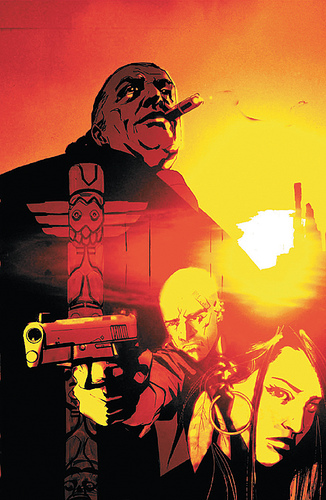
"Quite frankly it lacks the structure and the resolve to take the leadership in a comprehensive change in this jurisdiction," he said.
He recommended that Congress establish a criminal justice commission to propose reforms and a comprehensive new body of criminal law.
In the short term, he said, Congress should also boost funding for multijurisdictional task forces; establish family violence centers to focus on child abuse, sexual assault and domestic abuse; and devise ways to empower tribal courts and leaders to crack down on drug deals and domestic abusers.
Relations with federal law enforcement have broken down, said Marcus Wells Jr., chairman of the Three Affiliated Tribes--the Mandan, Hidatsa and Arikara--of the Fort Berthold Reservation in western North Dakota.
"I humbly ask for your help," he said.
Wells said of 10 federal officer positions for the reservation, three are continually vacant. That leaves seven BIA officers to patrol 1 million acres. And they are often detailed off-reservation without notice to the tribal government, he added.
This is a truth that's totally missing from the SCALPED comic book. SCALPED doesn't show us good people struggling against a bad system. It depicts the Indians themselves as bad. The lack of law-enforcement resources is irrelevant since the majority of SCALPED's Indians are criminals, thugs, and lowlifes.
In short, SCALPED is a classic case of blaming the victim for the problem.

Indians as rocket scientists
Williams: The little rocket that couldI received a letter from the College of Menominee Nation about students attending the tribal college in Wisconsin who competed in an aeronautical engineering contest against nine large engineering schools. The challenge: To design, build, fly and recover a high-powered rocket that could fly to an altitude of at least 3,000 feet and capture a photograph of a specially constructed image on the ground.
The CMN team's rocket, the Golden Eagle, not only achieved its goal, it exceeded it, by soaring to an altitude of 5,000 feet. The students, faculty and staff were ecstatic in their victory "with our little wooden and cardboard rocket" they called "the little rocket that could," over high-tech contenders constructed of fiberglass and carbon-fiber.
It is not surprising that the team succeeded. Indians have an innate natural intelligence and had an intimate relationship with the stars since prehistory. Plains Indians prepared winter counts, or histories of their tribes, based on the astral calendar; petroglyphs are believed to convey celestial events; and tepees and hogans were oriented to the stars and designed both to stay cool in the summer and warm in the winter. The stars hold a prominent place in Native spirituality and provide inspiration for participation in the great order of the universe. Many cultures believe that heavenly bodies are ancestors or carry their ancestors' spirits, and Indian astronomers chronicled events in the universe. 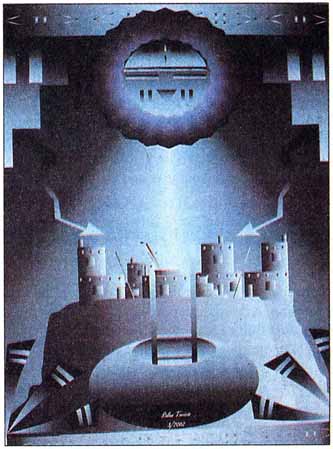
The CMN team's rocket, the Golden Eagle, not only achieved its goal, it exceeded it, by soaring to an altitude of 5,000 feet. The students, faculty and staff were ecstatic in their victory "with our little wooden and cardboard rocket" they called "the little rocket that could," over high-tech contenders constructed of fiberglass and carbon-fiber.
It is not surprising that the team succeeded. Indians have an innate natural intelligence and had an intimate relationship with the stars since prehistory. Plains Indians prepared winter counts, or histories of their tribes, based on the astral calendar; petroglyphs are believed to convey celestial events; and tepees and hogans were oriented to the stars and designed both to stay cool in the summer and warm in the winter. The stars hold a prominent place in Native spirituality and provide inspiration for participation in the great order of the universe. Many cultures believe that heavenly bodies are ancestors or carry their ancestors' spirits, and Indian astronomers chronicled events in the universe.

Watson to shut down Cherokee Nation?
Watson bill over freedmen could fall hard on Cherokee if compromise cannot be reached[O]utrage at the Cherokee has grown at a much greater pace since they expelled their freedmen members in a March vote that aroused international interest, and nowhere on Capitol Hill has it grown more than within the Congressional Black Caucus. The so-called 'dear colleague' letter to other congressional members that Watson circulated as a companion to her bill states that the Cherokee are pursuing "the sovereign right to discriminate," which she called "no right at all."
Watson's bill would pull approximately $300 million in federal funding from the Cherokee, suspend its gaming operations, and waive its sovereignty so that the freedmen could sue the tribe in court--all this "until such time as the Cherokee Nation restores full tribal citizenship to the Cherokee Freedmen," she states in her letter to colleagues.
As quoted in a media release, she added, "The Treaty of 1866 states unequivocally that the freedmen are citizens of the Cherokee Nation and have all the rights of Cherokees. It particularly pains me, over forty years after the passage of the historic Civil Rights Act, that legislation has to be introduced to compel the Cherokee Nation of Oklahoma to recognize the basic civil rights of the Cherokee Freedmen." 
Watson's bill would pull approximately $300 million in federal funding from the Cherokee, suspend its gaming operations, and waive its sovereignty so that the freedmen could sue the tribe in court--all this "until such time as the Cherokee Nation restores full tribal citizenship to the Cherokee Freedmen," she states in her letter to colleagues.
As quoted in a media release, she added, "The Treaty of 1866 states unequivocally that the freedmen are citizens of the Cherokee Nation and have all the rights of Cherokees. It particularly pains me, over forty years after the passage of the historic Civil Rights Act, that legislation has to be introduced to compel the Cherokee Nation of Oklahoma to recognize the basic civil rights of the Cherokee Freedmen."

Hip hop at the Eiteljorg
Eiteljorg's Indian Market will be artistic wellspring"I grew up with a traditional drum ceremony religion. We practice drum ceremonies that are based on the same philosophy as, I want to say, Christianity. We pray to the drum to get to God, in the same way as Christians pray to Jesus to get to God. Basically, there's only one higher power, only one creator."
When it came to a musical form of expression, it seemed natural for Malone to turn to hip-hop.
"African-Americans were sharing their culture and their ways. I thought it would be interesting for Native Americans to do that, too," said Malone, who has documented ancestry from the Oneida tribe.
"For me as a Native American, it was a way to channel my feelings and everything we go through as a culture. I also thought it would be an opportunity to give back to young Native people." 
When it came to a musical form of expression, it seemed natural for Malone to turn to hip-hop.
"African-Americans were sharing their culture and their ways. I thought it would be interesting for Native Americans to do that, too," said Malone, who has documented ancestry from the Oneida tribe.
"For me as a Native American, it was a way to channel my feelings and everything we go through as a culture. I also thought it would be an opportunity to give back to young Native people."

The family that laughs together...
Comedy clan
Family fun turns into comedy routines for BrownsIf you haven't heard about the Brown Comedy Show yet, it is just a matter of time.
The family of professional comics is climbing their way up to becoming a household name in the circle of Native American comedians. Hailing from Gallup, the Browns have been invited to places as far away as Florida, New York state, and Minnesota, to put on their comedy show. 
Family fun turns into comedy routines for Browns
The family of professional comics is climbing their way up to becoming a household name in the circle of Native American comedians. Hailing from Gallup, the Browns have been invited to places as far away as Florida, New York state, and Minnesota, to put on their comedy show.

Celebrity couple in Nunavut
Nunavut hockey star introduces American Idol girlfriend to familyRankin Inlet has been abuzz this week with sightings of a celebrity couple—hometown hockey hero Jordin Tootoo and his girlfriend, American Idol finalist Kellie Pickler.
The NHL player has been dating the country singer since January and has brought her home to Nunavut to meet his family. 
The NHL player has been dating the country singer since January and has brought her home to Nunavut to meet his family.

June 21, 2007
Diversity-speak = happy talk?
Americans couch feelings about race in 'happy talk' of diversity-speakAccording to a new study by researchers in the University of Minnesota's sociology department, Americans are generally positive--even optimistic--about the word 'diversity,' but when asked, even those working in the field of race relations have trouble describing diversity's value and stumble when giving real life examples.
The desire to appear color-blind leads most Americans to prefer the standardized language of diversity-speak when addressing issues of race, rather than the other way around. The researchers conclude that American diversity-speak is a sort of 'happy talk,' an upbeat language in which everyone has a place, everyone is welcome and even celebrated. Comment: It's hard to think of examples of diversity's value? No, it's easy.
Example: If we understood Muslims better, we might not have launched a disastrous war in Iraq. We might have saved thousands of lives and billions of dollars.
Example: If we understood American Indians better, we might uphold their treaties and sovereign rights. That would give them additional resources to pursue economic development and combat social ills.
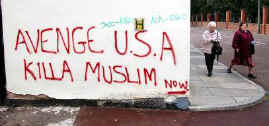
The desire to appear color-blind leads most Americans to prefer the standardized language of diversity-speak when addressing issues of race, rather than the other way around. The researchers conclude that American diversity-speak is a sort of 'happy talk,' an upbeat language in which everyone has a place, everyone is welcome and even celebrated.
Example: If we understood Muslims better, we might not have launched a disastrous war in Iraq. We might have saved thousands of lives and billions of dollars.
Example: If we understood American Indians better, we might uphold their treaties and sovereign rights. That would give them additional resources to pursue economic development and combat social ills.

Autistic kids recognize stereotypes
Autistic Children Recognize Stereotypes Based On Race And Sex, Study Suggests"Even with their limited capacities for social interaction and their apparent inability to orient to social stimuli, these autistic kids pick up and endorse social stereotypes as readily as normally developing kids," said Lawrence Hirschfeld of the New School for Social Research in New York. "One take-away point is that stereotypes are very easy to learn and very robust. They don't require higher order attention, or apparently even attention to social stimuli, to develop. Stereotypes can be learned even in the face of damage to the 'social brain' and under extraordinarily constrained conditions."
In fact, the researchers found that autistic children who have a verbal age between 6 and 7 years--and who fail ToM tasks--know and use gender and race stereotypes just like normal children. Hirschfeld said he suspects the stereotypes originate within subtle and seemingly incidental messages that saturate the culture--for example, through advertising or biased attention by the media. 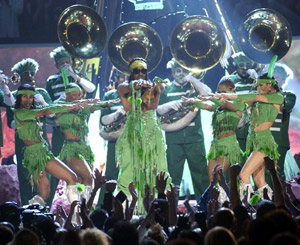
In fact, the researchers found that autistic children who have a verbal age between 6 and 7 years--and who fail ToM tasks--know and use gender and race stereotypes just like normal children. Hirschfeld said he suspects the stereotypes originate within subtle and seemingly incidental messages that saturate the culture--for example, through advertising or biased attention by the media.

Peltier play on the move
Leonard Peltier Play Could Come To SDSome call him a political prisoner. Others call him a cold-blooded killer. It's been 30 years since Leonard Peltier was sentenced to life in prison for murdering two FBI agents during a shootout on the Pine Ridge Indian Reservation. And people are still fascinated with his story.
Most recently, a Colorado woman adapted it into a play, which her company hopes to present across the country.
The new four-act play, based on the prison writings of Leonard Peltier, is meant to help others "meet" the convicted killer who still claims he's wrongly convicted.
The play's producers believe Peltier is paying the price for a crime he didn't commit. 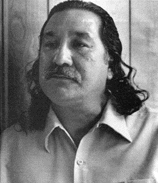
Most recently, a Colorado woman adapted it into a play, which her company hopes to present across the country.
The new four-act play, based on the prison writings of Leonard Peltier, is meant to help others "meet" the convicted killer who still claims he's wrongly convicted.
The play's producers believe Peltier is paying the price for a crime he didn't commit.

Road cuts through petroglyphs
Paseo extension through Petroglyphs opensResidents on Albuquerque's burgeoning west side heralded Wednesday's opening ofa four-lane section of Paseo del Norte, which cuts through 1,200 feet of Petroglyph National Monument.
The opening of the road caps more than a decade of legal battles involving a one-and-a-half-mile stretch that crosses the monument.
Many American Indians consider the petroglyphs--rocks with ancient markings etched by their ancestors--to be sacred spiritual touchstones. The director of the Sacred Alliance for Grassroots Equality, Sonny Weahkee, says he is angry about the road. 
The opening of the road caps more than a decade of legal battles involving a one-and-a-half-mile stretch that crosses the monument.
Many American Indians consider the petroglyphs--rocks with ancient markings etched by their ancestors--to be sacred spiritual touchstones. The director of the Sacred Alliance for Grassroots Equality, Sonny Weahkee, says he is angry about the road.

Nickel Indians played golf
Models for coin learned to play golfBorgeson is known for teaching the game to the three Native American men whose images were used to form the composite design for the nickel. They were Chief Two Guns White Calf, a member of the Blackfeet Tribe; John Big Tree, a Seneca; and Chief Iron Tail of the Sioux Tribe. The nickel was circulated around 1900.
"They made my grandpa and my grandma honorary members of the Blackfeet Indian Tribe," said Ulvedal, who was first taught to play golf at age 3 by his grandfather. "His name was Chief Eagle Tail Feathers and hers was Princess Mountain Climbing Woman. He was a huge influence on not only my golf but life in general." 
"They made my grandpa and my grandma honorary members of the Blackfeet Indian Tribe," said Ulvedal, who was first taught to play golf at age 3 by his grandfather. "His name was Chief Eagle Tail Feathers and hers was Princess Mountain Climbing Woman. He was a huge influence on not only my golf but life in general."

Bruce Willis on Indians
Ellen's a cardOn the subject of Bill Clinton: "I was apolitical for a long time, but Clinton got me off my a--. I didn't like his ideas of change just for the sake of change. In two terms, what did he get done? But I'm appalled by what's going on now. Look at the returning vets. The Walter Reed Hospital scandal is just another example of how we treat them. I say give them all a million dollars. If you serve your country and get blown up and you're in a wheelchair for the rest of your life or you lose an arm, you should be taken care of. How about no more paying taxes for them? Politicians never have problems voting themselves raises. How about giving money to veterans and American Indians?" said Willis. 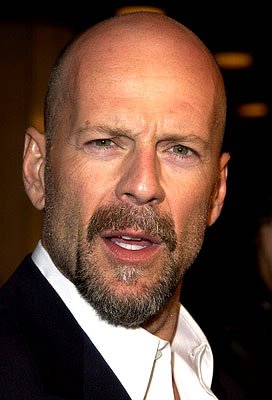

June 20, 2007
First gunshot victim in the Americas
Inca Skull Rewrites History of ConquestArchaeologists sensed they had unearthed an important find, but it wasn't until months later that a powerful electron microscope scan confirmed it by finding traces of lead in the skull. The victim, who was between 18 and 22 years old when he died, had been shot by a Spanish conquistador.
Given the age of the remains, as well as the age of other remains buried nearby, the archaeologists came to the conclusion that they had identified the earliest victim of a gunshot wound ever found in the Americas. What this find signifies:The history of the Incas' rapid defeat and decline, written almost entirely by the Spanish victors, has emphasized the valor and skill of the greatly outnumbered Europeans. Cock said the relatively new field of Inca archaeology is beginning to rewrite some of that story.
For instance, Cock said, there is good reason to believe the young gunshot victim died during the siege of Lima in 1536--one of numerous Inca uprisings following the execution of their leader, Atahualpa, by the Spanish. He also said there is archaeological and historical evidence to suggest those insurrections were put down with the help of native peoples who opposed the Incas' rule. The larger point about the clash of cultures:The fast decline of the Incas has generally been attributed to the far more advanced Spanish weaponry, the spread of European diseases to which native people had no immunity, and malnutrition and illness caused by the harsh working conditions imposed by the colonists.
Cock said all those factors doubtless played a role, but the ability of the Spaniards to establish native allies was also important and has been generally ignored.
"They joined Pizarro in the hope of being rewarded with more independence and freedom," Cock said. "I believe they wanted a more equal, more horizontal relationship with the Spaniards. Clearly, that did not happen." Comment: This point also applies to Cortés's victories over the Aztecs. In fact, it applies to many of the European victories over Indians. The Europeans didn't win because they were superior morally, intellectually, or technologically. They didn't win because "primitive" Natives cowered at the sight of horses or guns. They won because they played one tribe against another, especially in the case of the unloved Inca and Aztec empires.
For more on the subject, see Was Native Defeat Inevitable? and The Myth of Western Superiority.

Given the age of the remains, as well as the age of other remains buried nearby, the archaeologists came to the conclusion that they had identified the earliest victim of a gunshot wound ever found in the Americas.
For instance, Cock said, there is good reason to believe the young gunshot victim died during the siege of Lima in 1536--one of numerous Inca uprisings following the execution of their leader, Atahualpa, by the Spanish. He also said there is archaeological and historical evidence to suggest those insurrections were put down with the help of native peoples who opposed the Incas' rule.
Cock said all those factors doubtless played a role, but the ability of the Spaniards to establish native allies was also important and has been generally ignored.
"They joined Pizarro in the hope of being rewarded with more independence and freedom," Cock said. "I believe they wanted a more equal, more horizontal relationship with the Spaniards. Clearly, that did not happen."
For more on the subject, see Was Native Defeat Inevitable? and The Myth of Western Superiority.

Spanish coverup in 1536
Inca warrior's wound tells another tale
Archeologists in Peru identify the Americas' earliest reported gunshot victim, casting conquistadors as less than heroic in the siege of Lima.The records maintain that a few hundred conquistadors, led by Francisco Pizarro, used their superior weaponry and their horses to repel an attack by tens of thousands of Incas led by Manco Yupanqui. After breaking the siege, the Spaniards tracked down and killed many of the Incas who had attacked, including the group at Puruchuco.
But the evidence casts the conquistadors in a less heroic light, Cock found. The archeological evidence makes it clear that the Spaniards were accompanied by a large group of Indians who were fighting the Incas to escape subjugation.
Although as many as three of the Inca warriors were clearly shot and others had injuries apparently made by the Spaniards' metallic weapons, most of the 72 victims apparently were bludgeoned with more primitive stone weapons wielded by other Indians.
"The great siege must have taken place in a very different manner than we have been told," said Efrain Trelles Arestegui, a historian at the Pontifical Catholic University of Peru in Lima, who was not connected with the research. Only now, he added, are researchers revealing "the great cover-up that took place in the 16th century." 
Archeologists in Peru identify the Americas' earliest reported gunshot victim, casting conquistadors as less than heroic in the siege of Lima.
But the evidence casts the conquistadors in a less heroic light, Cock found. The archeological evidence makes it clear that the Spaniards were accompanied by a large group of Indians who were fighting the Incas to escape subjugation.
Although as many as three of the Inca warriors were clearly shot and others had injuries apparently made by the Spaniards' metallic weapons, most of the 72 victims apparently were bludgeoned with more primitive stone weapons wielded by other Indians.
"The great siege must have taken place in a very different manner than we have been told," said Efrain Trelles Arestegui, a historian at the Pontifical Catholic University of Peru in Lima, who was not connected with the research. Only now, he added, are researchers revealing "the great cover-up that took place in the 16th century."

Bio-piracy in Brazil
In the Amazon, Giving Blood but Getting NothingAs the Karitiana Indians remember it, the first researchers to draw their blood came here in the late 1970s, shortly after the Amazon tribe began sustained contact with the outside world. In 1996, another team visited, promising medicine if the Karitiana would just give more blood, so they dutifully lined up again.
But that promise was never fulfilled, and since then the world has expanded again for the Karitiana through the arrival of the Internet. Now they have been enraged by a simple discovery: their blood and DNA collected during that first visit are being sold by an American concern to scientists around the world for $85 a sample.
They want the practice stopped, and are demanding compensation for what they describe as the violation of their personal integrity. 
But that promise was never fulfilled, and since then the world has expanded again for the Karitiana through the arrival of the Internet. Now they have been enraged by a simple discovery: their blood and DNA collected during that first visit are being sold by an American concern to scientists around the world for $85 a sample.
They want the practice stopped, and are demanding compensation for what they describe as the violation of their personal integrity.

What's new with Notah?
Begay Happy To Be In U.S.Begay, 34, wants to earn back his PGA Tour card. "I started out so well my early in my career [with four victories in 1999 and 2000]," he said. "But I've struggled with my back mostly. Feel good, body hurts, rehab, play, then get hurt again. If my body is hurting, my game is hurting."
While resting the last six weeks, his spirits have been uplifted.
"I feel good about things I do off the course," said Begay, a Native American. "I started a foundation two years ago that works with Native Americans and awards a scholarship to encourage Native Americans to go to college. I work with tribes in golf business and consulting. ... And during the last two weeks, I spoke at two high school graduations." 
While resting the last six weeks, his spirits have been uplifted.
"I feel good about things I do off the course," said Begay, a Native American. "I started a foundation two years ago that works with Native Americans and awards a scholarship to encourage Native Americans to go to college. I work with tribes in golf business and consulting. ... And during the last two weeks, I spoke at two high school graduations."

Cherokees first to break treaty?
UKB Chief: Cherokee Nation can't hreak treatyTribes have worked hard to hold the United States to the promises made in Treaties. One thing that we Indians have always been able to stand proud and say is, “The United States has broken some treaties with us, but we have broken none.” Unfortunately, if the Smith administration succeeds in their illegal attempt to disenfranchise a class of citizens, we will never be able to say this again. All tribes in the United States will be affected, and will be put into the same category of “treaty breakers.” I fear this for all our Native Americans.
The Smith administration evidently believes itself to have more power than United States Congress by deciding to change the terms of a Treaty on their own, and eliminating citizenship and the right to vote for Freedman descendants. All Cherokees should stand together and protect their good name for the benefit of all Native Americans.
The Smith administration evidently believes itself to have more power than United States Congress by deciding to change the terms of a Treaty on their own, and eliminating citizenship and the right to vote for Freedman descendants. All Cherokees should stand together and protect their good name for the benefit of all Native Americans.
June 19, 2007
Review of Chickaloon comics
The Chickaloon Village in Alaska has produced three comics worthy of mention.
The stories are traditional legends intended to teach youngsters a moral lesson. The art by Dimi Macheras, who also drew STRONG MAN, is Saturday-morning-cartoonish but bold and dynamic. But the comics have a couple problems that make them less than ideal.
One is their purported messages. I don't know if the stories are literal legends or broad interpretations of legends, but the message in each case is muddled. It isn't what the creators think it is.
C'eyiige' Hwnax
Premise: Lynx is a polite guest at the "magic house" of the spirits; Raven isn't.
Purported message: Don't go into somebody's house uninvited.
Actual message: Beware of strangers who will attack and hurt you without telling you why.

Tsaani
Premise: A young man falls in love with a bear-girl but accidentally kills her. Enraged, the girl's bear-father seeks revenge.
Purported message: You have to be able to think no matter how bad your situation is.
Actual message: Don't fall in love with bear-girls. Don't shoot arrows without knowing your target. Watch out for jealous parents who can ruin your love life.

Besiin
Premise: An owl tortures and threatens to eat a crying child until the child's uncle rescues him.
Purported message: Don't spoil your children.
Actual message: Nature is nasty and dangerous. Children should be seen and not heard. Shut up your bawling brat or you'll pay the price.

The other problem with the Chickaloon comics is their price: $15 per comic?! Sure, they're printed on heavier stock than most comics, and they have 28 pages vs. the usual 24. But they're smaller than average (only 5" x 8") and have only one or two panels per page. I'd say they're worth about as much as any comic--i.e., $3.
At $3 apiece, these comics would be an interesting addition to your collection. But who can afford $15 per comic? Unless you have deep pockets or can wrangle a discount, give them a pass.
The stories are traditional legends intended to teach youngsters a moral lesson. The art by Dimi Macheras, who also drew STRONG MAN, is Saturday-morning-cartoonish but bold and dynamic. But the comics have a couple problems that make them less than ideal.
One is their purported messages. I don't know if the stories are literal legends or broad interpretations of legends, but the message in each case is muddled. It isn't what the creators think it is.
C'eyiige' Hwnax
Premise: Lynx is a polite guest at the "magic house" of the spirits; Raven isn't.
Purported message: Don't go into somebody's house uninvited.
Actual message: Beware of strangers who will attack and hurt you without telling you why.

Tsaani
Premise: A young man falls in love with a bear-girl but accidentally kills her. Enraged, the girl's bear-father seeks revenge.
Purported message: You have to be able to think no matter how bad your situation is.
Actual message: Don't fall in love with bear-girls. Don't shoot arrows without knowing your target. Watch out for jealous parents who can ruin your love life.

Besiin
Premise: An owl tortures and threatens to eat a crying child until the child's uncle rescues him.
Purported message: Don't spoil your children.
Actual message: Nature is nasty and dangerous. Children should be seen and not heard. Shut up your bawling brat or you'll pay the price.

The other problem with the Chickaloon comics is their price: $15 per comic?! Sure, they're printed on heavier stock than most comics, and they have 28 pages vs. the usual 24. But they're smaller than average (only 5" x 8") and have only one or two panels per page. I'd say they're worth about as much as any comic--i.e., $3.
At $3 apiece, these comics would be an interesting addition to your collection. But who can afford $15 per comic? Unless you have deep pockets or can wrangle a discount, give them a pass.
Review of CHIPPEWAS OF NAWASH
THE ILLUSTRATED HISTORY OF THE CHIPPEWAS OF NAWASH is just what it proclaims to be. Specifically, it describes how Europeans stole the Canadian tribe's land and how the Chippewas are fighting for and winning back their rights today.
As its website notes, the graphic novel is
thoroughly researched and referenced ... 18 pages of references to original documents, 5 coloured maps, all the relevant treaties reprinted in full, and a page of Ojibway words used in the text.
educational ... Each of the 11 episodes tells a story that is familiar to all Anishnabe and which should be familiar to all Canadians. Together the episodes show how First Nations lost their lands and resources and how, now, they are re-gaining them.
The historical episodes detail how the Canadian government managed to take most of the Chippewa land: by playing on the Indians' lack of knowledge; by pitting one faction against another; by stalling, making empty promises, or lying outright; by threatening dire consequences if the Indians didn't sign; etc. You get a sense of how the Canadian government (and by extension, the US government) dealt with Indians unfairly, manipulated and misled them, every step of the way.
This is simultaneously the book's strength and weakness. Since there's no central character or storyline, just a series of loosely connected episodes, it's rather tough slogging. I suspect many youngsters will be bored rather than stimulated by the "educational," "thoroughly researched" material.
The standard framing device--a grandfather enlightening his uncaring grandchildren--offers only a bit of relief. This is where a series like CHICKASAW ADVENTURES shines--at least in theory. Via magic, it thrust a modern-day boy into the middle of the action, so he could experience historical events firsthand. Something like that is needed here.
Therefore, I can't recommend the ILLUSTRATED HISTORY to anyone looking for an entertaining read. It's basically for educational purposes only. Completists may want to get a copy, but others can give it a pass.
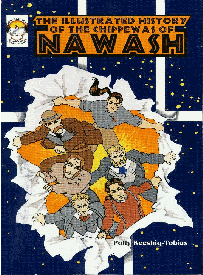
As its website notes, the graphic novel is
The historical episodes detail how the Canadian government managed to take most of the Chippewa land: by playing on the Indians' lack of knowledge; by pitting one faction against another; by stalling, making empty promises, or lying outright; by threatening dire consequences if the Indians didn't sign; etc. You get a sense of how the Canadian government (and by extension, the US government) dealt with Indians unfairly, manipulated and misled them, every step of the way.
This is simultaneously the book's strength and weakness. Since there's no central character or storyline, just a series of loosely connected episodes, it's rather tough slogging. I suspect many youngsters will be bored rather than stimulated by the "educational," "thoroughly researched" material.
The standard framing device--a grandfather enlightening his uncaring grandchildren--offers only a bit of relief. This is where a series like CHICKASAW ADVENTURES shines--at least in theory. Via magic, it thrust a modern-day boy into the middle of the action, so he could experience historical events firsthand. Something like that is needed here.
Therefore, I can't recommend the ILLUSTRATED HISTORY to anyone looking for an entertaining read. It's basically for educational purposes only. Completists may want to get a copy, but others can give it a pass.

"Shishmaref: We Are Worth Saving!"
Shishmaref puts cry for help on Web
RELOCATION: Village needs lots of money and expertise to move.Residents of Shishmaref, an Inupiat Eskimo village whose island home is being eaten away by the sea, are turning to the Internet for help in making a multi-million dollar move to the mainland of Northwestern Alaska.
"Shishmaref: We Are Worth Saving!" is the message on www.shishmarefrelocation.com, the newly established Web site of the Shishmaref Erosion and Relocation Coalition. "To not act represents the annihilation of our community by dissemination."
The 610 residents of Shishmaref are united in their wish to relocate from the barrier reef island--just a quarter of a mile wide and three miles long--to a new location on the mainland, five miles away.
To do so, they need about $180 million, and a lot of expertise, from planners and grant writers to engineers, geologists and cultural anthropologists, said Tony Weyiouanna Sr., a village transportation planner employed through Kawerak, a nonprofit regional firm that provides a variety of services to communities in the Nome region. 
RELOCATION: Village needs lots of money and expertise to move.
"Shishmaref: We Are Worth Saving!" is the message on www.shishmarefrelocation.com, the newly established Web site of the Shishmaref Erosion and Relocation Coalition. "To not act represents the annihilation of our community by dissemination."
The 610 residents of Shishmaref are united in their wish to relocate from the barrier reef island--just a quarter of a mile wide and three miles long--to a new location on the mainland, five miles away.
To do so, they need about $180 million, and a lot of expertise, from planners and grant writers to engineers, geologists and cultural anthropologists, said Tony Weyiouanna Sr., a village transportation planner employed through Kawerak, a nonprofit regional firm that provides a variety of services to communities in the Nome region.

Anna Nicole's room gutted
No Hard Rock shrine for Anna NicoleThe casino hotel room where Anna Nicole Smith died in February is no more.
The luxury $800-a-day suite at the Seminole Hard Rock Hotel & Casino near Hollywood--room 607--has been completely gutted, remodeled, refurnished--and renumbered.
There is no room 607 anymore, said Gary Bitner, spokesman for the Seminole Tribe of Florida.
"We did not want that room to become a shrine."
Bitner refused to confirm or deny that a Seminole shaman performed a spiritual cleansing ceremony on the room before and after the renovation work, which was completed two months ago. 
The luxury $800-a-day suite at the Seminole Hard Rock Hotel & Casino near Hollywood--room 607--has been completely gutted, remodeled, refurnished--and renumbered.
There is no room 607 anymore, said Gary Bitner, spokesman for the Seminole Tribe of Florida.
"We did not want that room to become a shrine."
Bitner refused to confirm or deny that a Seminole shaman performed a spiritual cleansing ceremony on the room before and after the renovation work, which was completed two months ago.

Indian culture strikes back
Falling totem pole kills boy at Pa. campA 13-foot totem pole fell and struck a boy on the first day of Boy Scout camp, killing the 9-year-old, police said Monday.
Tyler O. Shope, of Shermans Dale, died of head and chest injuries Sunday afternoon, Perry County Coroner Michael Shalonis said.
Tyler O. Shope, of Shermans Dale, died of head and chest injuries Sunday afternoon, Perry County Coroner Michael Shalonis said.
June 18, 2007
Thoughts on "Legacy and Legend"
I saw this exhibit at the Huntington Library Sunday. It consisted mainly of drawings, paintings, and photographs by the artists who encountered Indians--e.g., White, de Bry, McKenney and Hall, Catlin, Bodmer, Curtis, Moon--and wanted to popularize and preserve their cultures.
There were some fascinating things on display. For instance, the first woodcut of Indians from Columbus's voyages in its original 1495 printing. Portraits and engravings so lifelike they looked photo-realistic. Photographs that belong in the Photograph Hall of Fame if they aren't there already.
Unfortunately, there were few depictions by those who hadn't met Indians and wanted only to exploit them--i.e., in posters, playbills, and dime-novel illustrations. And nothing from the 20th century except the Curtis and Moon photographs--no movie stills, product packaging, or sports memorabilia.
There could've been more effort to put the illustrations into context--to explain how the images changed over time, how Americans used them to further their own agenda. Curator Hight's statement tells you'd more than you'd probably learn from the exhibit itself.
Some additional thoughts:
The exhibit notes that Pocahontas means "playful, frolicsome child" in Algonquian. John Smith and other Jamestown residents called her this name in their writings and didn't refer to Matoaka, her real name. This raises the possibility the woman who married John Rolfe wasn't the same one who helped the settlers earlier--that Smith and the others may have encountered several frolicsome children.
It's surprising to learn how much the artists "cheated" reality. They copied figures from previous works or modeled them on figures in classical paintings. They imagined or reimagined their works in the studio after taking notes in the field. They added or changed elements to "improve" their works and make them more marketable.
This last point applies to the photographers too, of course. Curtis was notorious for his theme of the vanishing Indian: "chiefs in feathered headdresses, aging patriarchs, women struggling to manage, and the war parties of past eras." It wasn't until sometime in the 20th century that someone tried to capture Indians the way they were, without editing or "enhancing."
The Plains Indian images (chiefs, warriors, tipis, etc.) didn't come to dominate American perceptions until after the Civil War. Before then, diverse depictions of Indians east of the Mississippi were the norm. These Indians wore turbans, jackets, sashes, and robes, not feathers and buckskins. McKenney and Hall's portrait of the Seneca orator Red Jacket (below) may have been the most well-known Indian picture at the time.
It's not clear from the exhibit how Plains Indian images came to dominate, but one can guess. As westward expansion became the driving force in American politics, the Indian had to go. It became expedient to portray Indians as backward, savage, primitive, out-of-date, ill-fated, doomed. Showing Indians living in peaceful homes and villages, wearing Western-style clothes, calm and thoughtful, didn't serve America's purpose. Showing them as half-naked barbarians, wild and untamed, hunting buffalo like wolves, did.
One exception to the exhibit's "authentic" art was an infamous painting of Custer's Last Stand. As one website notes, the "painting by Otto Becker and Cassilly Adams depicted the 7th Cavalry's last stand as a floridly romantic event. That became the image of the scene for a large segment of the nation, because the painting was distributed as a lithograph by Anheuser Busch to 150,000 barrooms."
The exhibit calls photographs the "bridge to motion pictures." So the line from the earliest engravings to shoot-'em-up Westerns and thence to mascots, cartoons, and other modern-day sources of stereotypes is pretty straight.

There were some fascinating things on display. For instance, the first woodcut of Indians from Columbus's voyages in its original 1495 printing. Portraits and engravings so lifelike they looked photo-realistic. Photographs that belong in the Photograph Hall of Fame if they aren't there already.
Unfortunately, there were few depictions by those who hadn't met Indians and wanted only to exploit them--i.e., in posters, playbills, and dime-novel illustrations. And nothing from the 20th century except the Curtis and Moon photographs--no movie stills, product packaging, or sports memorabilia.
There could've been more effort to put the illustrations into context--to explain how the images changed over time, how Americans used them to further their own agenda. Curator Hight's statement tells you'd more than you'd probably learn from the exhibit itself.
Some additional thoughts:
This last point applies to the photographers too, of course. Curtis was notorious for his theme of the vanishing Indian: "chiefs in feathered headdresses, aging patriarchs, women struggling to manage, and the war parties of past eras." It wasn't until sometime in the 20th century that someone tried to capture Indians the way they were, without editing or "enhancing."

New Native ad agency
New ad agency has ties to Native American communityA Native American business owner has partnered with a tribal business organization to create a new Twin Cities advertising agency.
Chad Germann and the Potawatomi Business Development Corp. teamed up to start full-service advertising firm, called Howl Fire. With offices in Minneapolis and Milwaukee, Howl Fire will support the PBDC family of companies and target Fortune 1000 business-to-business clients.
Chad Germann and the Potawatomi Business Development Corp. teamed up to start full-service advertising firm, called Howl Fire. With offices in Minneapolis and Milwaukee, Howl Fire will support the PBDC family of companies and target Fortune 1000 business-to-business clients.
Trivia question from "Legacy and Legend"
Who was the first Indian in US history to be depicted wearing a feathered headdress?
June 17, 2007
Indians know climate change
Indians speak forcefully on climate
US tribes join discourse on global warmingThe Mohawk Indian, along with members of five other Native American tribes, was preparing for a sacred ceremony by the river to pray for "Earth Mother." He said the planet was reacting to the overwhelming amount of pollution humans have produced that caused changes around the globe, even in the river at his doorstep.
"Earth Mother is fighting back--not only from the four winds but also from underneath," he said. "Scientists call it global warming. We call it Earth Mother getting angry."
In recent months, some Native American leaders have spoken out more forcefully from New Hampshire to California about the danger of climate change from greenhouse gases, joining a growing national discourse on what to do about the warming planet.
Scientists have documented climate change, but Native Americans speak of it in spiritual terms and remind others that their elders prophesized environmental tragedy many generations ago.
Those who study Native American culture believe their presence in the debate could be influential. They point to "The Crying Indian," one of the country's most influential public-service TV ads.
In the spot, actor Iron Eyes Cody, in a buckskin suit, paddles a canoe up a trash-strewn urban creek, then stands by a busy highway cluttered with litter. The ad ends with a close-up of Cody, shedding a single tear after a passing motorist throws trash at his feet.
The "Keep America Beautiful" public service announcement , which aired in the 1970s and can be seen on YouTube.com, helped usher in landmark environmental laws, including the Clean Water Act and the Endangered Species Act.
"Within the last six months, there's just been a loss of faith in the insistence [by some politicians] that global warming isn't happening, and that we have nothing to do with it," said Shepard Krech III , an anthropology and environmental studies professor at Brown University.
Krech is the author of "The Ecological Indian," which examines the relationship between Native Americans and nature. Comment: Krech's comment is ironic considering he spent most of The Ecological Indian denigrating Indians' environmental stewardship. See Dennis Prager and The Ecological Indian for more on the subject.
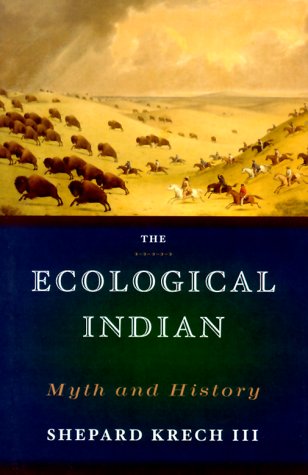
US tribes join discourse on global warming
"Earth Mother is fighting back--not only from the four winds but also from underneath," he said. "Scientists call it global warming. We call it Earth Mother getting angry."
In recent months, some Native American leaders have spoken out more forcefully from New Hampshire to California about the danger of climate change from greenhouse gases, joining a growing national discourse on what to do about the warming planet.
Scientists have documented climate change, but Native Americans speak of it in spiritual terms and remind others that their elders prophesized environmental tragedy many generations ago.
Those who study Native American culture believe their presence in the debate could be influential. They point to "The Crying Indian," one of the country's most influential public-service TV ads.
In the spot, actor Iron Eyes Cody, in a buckskin suit, paddles a canoe up a trash-strewn urban creek, then stands by a busy highway cluttered with litter. The ad ends with a close-up of Cody, shedding a single tear after a passing motorist throws trash at his feet.
The "Keep America Beautiful" public service announcement , which aired in the 1970s and can be seen on YouTube.com, helped usher in landmark environmental laws, including the Clean Water Act and the Endangered Species Act.
"Within the last six months, there's just been a loss of faith in the insistence [by some politicians] that global warming isn't happening, and that we have nothing to do with it," said Shepard Krech III , an anthropology and environmental studies professor at Brown University.
Krech is the author of "The Ecological Indian," which examines the relationship between Native Americans and nature.

Review of "Legacy and Legend"
Not always drawn from life
Depictions of Native Americans often reflected what artists wanted to see, a Huntington display shows.Most of the exhibition is devoted to material from the 19th century, when interest in Native Americans had a resurgence precipitated by the Louisiana Purchase and the Lewis and Clark Expedition of 1804, which sparked the westward expansion. Advancements in printing techniques, especially in lithography, made it possible for this round of images to be widely disseminated. And these depictions also helped feed a push by poets and writers for a national myth, says Hight. "They were looking for a long history rooted in the land, and Indians were part of that."
As westward expansion met resistance from the Indians whose lands and resources were being taken, darker imagery began to emerge. In a mid-19th century print, "Death Whoop," artist Seth Eastman depicts an Indian scalping a cowboy. Hight calls it an "inflammatory image," which was unfortunately reproduced on the title page of a series of books prepared for Congress. And, of course, there is a print of Custer's last stand, showing Custer brave and stalwart with his handful of men as Lakotas and Cheyennes close in on them—a scene now considered bogus. But such heroic moments were popular in saloons, and this poster-sized version, after a painting by Cassily Adams, was made in 1896 to advertise Budweiser beer. 
Comment: Now you know one of the sources for the inflammatory cover of last December's Dartmouth Review.
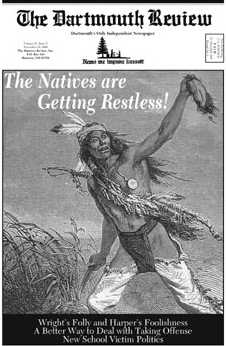
Depictions of Native Americans often reflected what artists wanted to see, a Huntington display shows.
As westward expansion met resistance from the Indians whose lands and resources were being taken, darker imagery began to emerge. In a mid-19th century print, "Death Whoop," artist Seth Eastman depicts an Indian scalping a cowboy. Hight calls it an "inflammatory image," which was unfortunately reproduced on the title page of a series of books prepared for Congress. And, of course, there is a print of Custer's last stand, showing Custer brave and stalwart with his handful of men as Lakotas and Cheyennes close in on them—a scene now considered bogus. But such heroic moments were popular in saloons, and this poster-sized version, after a painting by Cassily Adams, was made in 1896 to advertise Budweiser beer.

Comment: Now you know one of the sources for the inflammatory cover of last December's Dartmouth Review.

June 16, 2007
Who controls Sitting Bull?
Battle Over Memorializing Sitting Bull
What one side wants:The two men who want to turn Sitting Bull's resting place into a memorial complex are Rhett Albers, an environmental consultant who is white, and Bryan Defender, who owns the sanitation system for the Standing Rock tribe and is enrolled there.
They say people who come to the banks of the Missouri to see the site are confused--wondering: Well, where is the rest of it?
Their plan for the site would stream visitors through an "interpretive center," focused on the four Sioux ideals they say Sitting Bull represented: Fortitude, generosity, bravery and wisdom.
Other features under consideration are a snack bar, offices and meeting rooms, a gift shop and a restaurant serving wild game and American Indian dishes. What the other side wants:LaPointe, 58, believes the plans for a memorial complex atop his great-grandfather's grave are doing worse--cashing in.
"They want to use our grandfather," he says, speaking for his three sisters, "as a tourist attraction."
So this February he drafted a letter. He sent it to an assortment of Sioux tribes, including Standing Rock, which claims Sitting Bull.
"North Dakota, South Dakota and the Standing Rock Sioux Tribe have not honored their promise for proper care and maintenance of our Grandfather's burial sites," the letter said.
It called for a "final reburial"--in Montana, at the site of Little Bighorn. 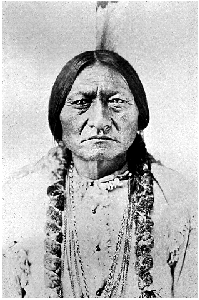
What one side wants:
They say people who come to the banks of the Missouri to see the site are confused--wondering: Well, where is the rest of it?
Their plan for the site would stream visitors through an "interpretive center," focused on the four Sioux ideals they say Sitting Bull represented: Fortitude, generosity, bravery and wisdom.
Other features under consideration are a snack bar, offices and meeting rooms, a gift shop and a restaurant serving wild game and American Indian dishes.
"They want to use our grandfather," he says, speaking for his three sisters, "as a tourist attraction."
So this February he drafted a letter. He sent it to an assortment of Sioux tribes, including Standing Rock, which claims Sitting Bull.
"North Dakota, South Dakota and the Standing Rock Sioux Tribe have not honored their promise for proper care and maintenance of our Grandfather's burial sites," the letter said.
It called for a "final reburial"--in Montana, at the site of Little Bighorn.



